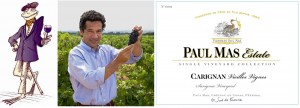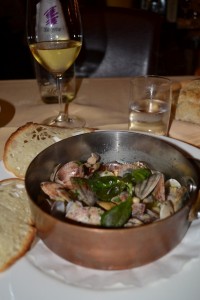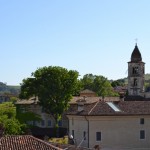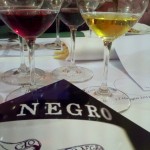Category Archives: Sparkling Wine
Alsace does it again: Food-friendly French wines
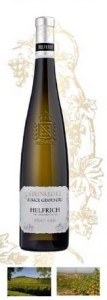 In yet another stellar example of how well Alsatian wines pair with food, we ordered nearly one of everything on the French-Asian menu at Rouge & Blanc and let the forks fly.
In yet another stellar example of how well Alsatian wines pair with food, we ordered nearly one of everything on the French-Asian menu at Rouge & Blanc and let the forks fly.
Admittedly, some pairings were preferred over others, but nothing clashed and almost all worked reasonably well. We also appreciated how the luscious fruit and slightly off-dry palate of the Pinot Gris and Gewurztraminer provided a nice counterpoint to the spiciness of some of the dishes.
The following menu items, pulled from the restaurant’s website, should provide some indication as to the varied nature of our meal and, consequently, the flexibility of the wines.
- Duck Egg Pissaladière, Caramelized Shallot, Reading Raclette
- Cured Arctic Char, Smoked Pickles, Mustard Vinaigrette, Crostini
- Grilled Pork Belly, Charred Vietnamese Corn, Market Relish
- Glazed Lamb Ribs, Sesame, Cucumber Herb Salad
- Hanoi Fried Chicken, Lemongrass Aioli, Summer Pickles
The occasion for our little game was a visit from Anne-Laure Helfrich, the third generation of her family at work in the family business. Established in 1934, Helfrich winery produces a full range of Alsatian whites from the sparkling Cremant d’Alsace to Grand Cru designated wines and several in between.
While I haven’t yet been to Alsace, it remains one of my favorite French wine regions. Its distinct varietal wines are easy to understand and generally easy on the wallet, even at classified levels – nothing we tasted topped $19.99.
Starting with the Cremant d’Alsace ($19.99), produced from 100% Pinot Blanc, it served as a terrific aperitif as we got to know Anne-Laure and our fellow diners, with just the right balance of citrus fruit and yeasty/ toasty notes stemming from its Traditional Method production.
We next opened up the still Pinot Blanc 2012 ($14.99), which, as Anne-Laure explained, can be found in everyone’s fridge in Alsace, due to its overall food-friendly nature and easy drinkability. The Helfrich Pinot Blanc did not disappoint in this regard, displaying smoke, pear and almond notes on both the nose and palate.
The Riesling 2012 ($14.99) was full of orange blossom and tangerine aromas, with refreshing acidity, citrus and pith on the dry palate. The Pinot Gris 2012 ($14.99) was similarly citrus in character, but was slightly off-dry, with almond and spice. The Gewurztraminer 2012 ($14.99) was classic with floral and tropical fruit and only a hint of residual sugar.
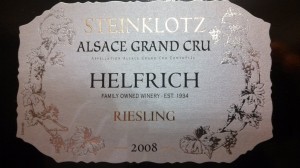 The Grand Cru wines hail from the famed Steinklotz Vineyard, which boasts of being the oldest documented vineyard in Alsace as recorded in 589. Located at the northern end of the region, near Strasbourg, the vineyard is quite steep with chalky soils.
The Grand Cru wines hail from the famed Steinklotz Vineyard, which boasts of being the oldest documented vineyard in Alsace as recorded in 589. Located at the northern end of the region, near Strasbourg, the vineyard is quite steep with chalky soils.
These wines, all priced at $19.99, showed more complexity and depth than their non-Grand Cru counterparts. The Riesling Grand Cru 2011 was steely, with intense minerality, lime/citrus notes and long length, while the Pinot Gris Grand Cru 2011 was lush with rich tropical fruit, smoke and floral notes. The richness and concentration of this latter wine offered a perfect example of how a white wine could not only stand up, but pair well with smoky, sweet ribs and salty, spicy pork belly.
All in all, it was a wonderful meal, punctuated with well-made wines and great company.
Moscato by twos
As one of the oldest grape varieties, Muscat (alternately known as Moscato) continues to be among the top grapes produced worldwide. Most recently, it has become increasingly popular in the U.S. market. While more known for its sweeter styles of wine, this variety can also be used to make dry wines. However, off-dry styles seem to dominate. And, with their lower alcohol levels, these are wines that will keep your head clear after a second glass.
As evidence of its popularity around the globe, such wines hail from Italy, California and even Brazil. And, they frequently come in pairs – with a white and pink version available — and may be still or sparkling.
Vinicola Aurora Carnaval Moscato White Espumante NV, Serra Gaúcha, Brazil, $13.00
A Charmat Method sparkling wine produced from Moscato Bianco and Moscato Giallo grapes, this wine offers up floral and peach aromas. On the palate, it is off-dry, nicely balanced by acidity, with white flowers and juicy, ripe peach flavors; simple, but balanced and refreshing.
Vinicola Aurora Carnaval Moscato Pink Espumante NV, Serra Gaúcha, Brazil, $13.00
From the same producer and grape variety, this wine is produced similarly to the Moscato White, but it is medium salmon in color with red flowers and red fruit. Strawberry and cherry flavors co-mingle on the off-dry palate, which is slightly sweeter than the Moscato White, yet finishes very cleanly.
Martin Weyrich Moscato Allegro 2011, California, $12.00
Produced from 100% Muscat Canelli, this is a still wine, but with a very slight effervescence perceptible in the glass and on the palate. Floral aromas greet the nose, joined by anise, sage and pear. The off-dry palate has medium+ acidity, with floral, pear, sage and slight anise/spice notes. Despite the noticeable sweetness, it finishes quite cleanly.
Martin Weyrich Pink Moscato Allegro 2011, California, $12.00
This wine is also a product of the Muscat Canelli grape, but “with just a kiss of red wine” giving it its pale pink hue. It has aromas of floral, berries and melon on the nose. Its slightly off-dry palate is less sweet than its white counterpart with slight spice, herbal and anise notes.
Grand Cru Grapevine: Laisser Les Bons Temps Rouler, An Introduction to Brazilian Wines (February 2013)
Home to the biggest carnival celebration worldwide (and thought of as the benchmark for all others), Brazil knows how to party! But, when it comes to libations, Brazil has been much more known for its cachaça than for its wine. In fact, although Brazil is the largest country in South America in terms of land mass, it only ranks third in terms of wine production, well behind Argentina and Chile. Previously, its wine was rarely seen outside the country mostly because the quality was not up to world standards and domestic demand was sufficient to account for most of the production. However, as in many emerging wine markets, times are changing and Brazilian wine has seen significant improvement. Moreover, Brazilian wine producers are beginning to share their wines with the world, with several of these wines now available in the U.S.
As a wine producing country, Brazil faces several challenges. Since only the southernmost part of Brazil extends into the temperate latitudes suitable for grapegrowing, nearly all of the production is centered here. But, despite being more moderate than the rest of Brazil, the region is still hot and humid given its proximity to the equator. Interestingly, this geographic position means that the vines can go through two complete growing cycles, permitting two harvests annually. To combat the humidity, the majority of the vineyards are planted with native American and French-American hybrid varieties, which are much more mildew resistant. Yet, most of the international varieties are grown as well, along with Moscato, Glera (the grape used to produce Italy’s Prosecco) and Pinotage. And, the reliance on these grapes is increasing.
Much of the Brazilian wine renaissance has taken place in southeastern Brazil, which accounts for most of Brazil’s vineyard land. This larger area can be divided into five distinct regions: Serra Gaúcha, Campanha, Serra do Sudeste, Campos de Cima da Serra, and Planalto Catarinense. A sixth region, Vale do São Francisco, is located in the northeast of Brazil. Within Serra Gaúcha is the country’s only official Denominazione di Origem (DO): Vale dos Vinhedos. While Vale dos Vinhedos originally gained recognition in 2001 as an Indication of Origin (IO), which was recognized by European Union in 2007, the valley was granted the higher status of DO in 2011. Wines holding this classification must comply with more specific regulations regarding the production of grapes and winemaking. Chief among the regulations, only vitis vinifera (European) grape varieties are permitted, with Merlot and Chardonnay being specified as the flagship grapes and requiring 85 percent minimums for varietal labeling of these wines. In addition to single variety wines, red blends are produced as are sparkling wines in both the Tank and Traditional Methods. As Brazil’s wine industry continues its upward trajectory, let’s raise a glass and let the good times roll.
TASTING NOTES
Vinicola Aurora Carnaval Moscato White Espumante NV, Serra Gaúcha, Brazil, $13.00 A Charmat Method sparkling wine produced from Moscato Bianco and Moscato Giallo grapes, this wine offers up floral and peach aromas. On the palate, it is off-dry, nicely balanced by acidity, with white flowers and juicy, ripe peach flavors; simple, but balanced and refreshing.
Vinicola Aurora Carnaval Moscato Pink Espumante NV, Serra Gaúcha, Brazil, $13.00
From the same producer and grape variety, this wine is produced similarly to the Moscato White, but it is medium salmon in color with red flowers and red fruit aromas. Strawberry and cherry flavors co-mingle on the off-dry palate, which is slightly sweeter than the Moscato White, yet finishes very cleanly.
Basso Monte Paschoal Virtus Moscato 2011, Serra Gaúcha, Brazil, $16.00 Like many South Americans, the Basso family came from Italy in the late 1800s and established their current facility in 1940. Exhibiting classic Muscat aromas of floral/jasmine, Asian pear, peach and a hint of grapiness, this wine is a pleasant surprise given its dry and medium-bodied palate with sufficiently vibrant acidity. Very refreshing and easily paired with a variety of cuisine.
Salton Talento 2007, Serra Gaúcha, Brazil, $26.00
The Salton Winery was the first Brazilian winery to celebrate its 100th anniversary and is presently run by the third generation of the family. The Talento is a blend of 60% Cabernet Sauvignon, 30% Merlot and 10% Tannat, which has been aged for 12 months in French oak barrels. Meaty, red fruit and slight spice aromas greet the nose, joined by herbal and coffee notes on the dry, medium-to-full bodied palate.
Salton Desejo 2007, Serra Gaúcha, Brazil, $26.00
Salton’s Desejo is produced from 100% Merlot, which has been aged in oak barrels (50% French; 50% American oak) for 12 months. The wine has aromas of dried herbs, cut grass and black cherry, all of which persist on the full-bodied palate, coupled with anise and spice.
Lidio Carraro Grande Vindima Quorum 2009, Vale dos Vinhedos, Brazil, $65.00
Produced only in the best years, the Grande Vindima 2006 is a blend of 40% Merlot, 25% Cabernet Sauvignon, 20% Tannat and 15% Cabernet Franc, with no time spent in wood. The nose is dominated by cinnamon, red fruit and sage, while floral and minty notes present on the palate, culminating in long length.
Grand Cru Grapevine: Through Rose-colored Glasses (January 2013)
 In keeping with an optimistic spirit, Rosé Champagne is the perfect wine to kick off the new year! As Ed McCarthy exclaimed at the Wine Media Guild’s annual Champagne luncheon in December, “Rosé Champagne is ‘in’!” Its success has been a bit surprising to everyone, including the Champenois, given that Rosé Champagne was considered an afterthought only 12 years ago. Now, it makes up 8% of the market and is on the rise. This continued trajectory is equally surprising considering that it is more expensive than regular (non-rosé) Champagne. But, it is also more intensive and, at least according to Ed, “Everybody loves it!” Whether this latter statement is fact or hyperbole, what is true is that Rosé Champagne has a fuller body than regular Champagne, due to the increased ratio of Pinot Noir grapes and is extremely food friendly.
In keeping with an optimistic spirit, Rosé Champagne is the perfect wine to kick off the new year! As Ed McCarthy exclaimed at the Wine Media Guild’s annual Champagne luncheon in December, “Rosé Champagne is ‘in’!” Its success has been a bit surprising to everyone, including the Champenois, given that Rosé Champagne was considered an afterthought only 12 years ago. Now, it makes up 8% of the market and is on the rise. This continued trajectory is equally surprising considering that it is more expensive than regular (non-rosé) Champagne. But, it is also more intensive and, at least according to Ed, “Everybody loves it!” Whether this latter statement is fact or hyperbole, what is true is that Rosé Champagne has a fuller body than regular Champagne, due to the increased ratio of Pinot Noir grapes and is extremely food friendly.
As Champagne, Rosé Champagnes are produced using the Méthode Champenoise, referred to as the Traditional Method for similar wines produced elsewhere. These wines spend considerable time aging in contact with dead yeast cells that give the wines their yeasty, leesy, bready aromas and flavors. In addition, Rosé Champagnes also have fruitier aromas and flavors that are derived from the heavier reliance on Pinot Noir and the deliberate creation of color. While Pinot Noir is a component of most Champagnes —the obvious exception being the blanc de blancs (white from whites) style—Champagne producers are careful to avoid extracting color from the grapes’ skins. However, when creating a Rosé Champagne, the focus shifts and some color attainment is permitted. Such color may be produced through the saignée method (as is often used for still rosé wines), or by creating a cuvée that includes red wine in the blend to produce a pinkish base wine. However, red wine may be blended in at the end with the dosage instead to avoid potential browning during the lees aging period. Regardless of when it occurs, sparkling wine production is the only time that adding red wine to a white wine is acceptable in creating a rosé-style wine.
The wines featured in this month’s newsletter are some of my favorites from the December lunch at which we tasted a total of 15 wines. As noted, these are pricey wines, but, thankfully, many of my preferred wines were on the lower end of the spectrum.
TASTING NOTES
Ayala Brut Rosé NV, $48-54.00
We’ve featured Ayala, the sister brand of Bollinger, before, but as it is always continues to perform well in comparative tastings it is worth featuring again. With rich fruit aromas of floral and ripe strawberry and slight yeasty notes, this wine was elegant on the palate with a delicate mousse.
Alfred Gratien Brut Rosé NV, $62-75.00
At the luncheon, Ed noted that he was very impressed with this wine, as was I. It displayed a very yeasty character on the nose with melon aromas and flavors. It was dry with very high acidity, finishing quite cleanly on the palate.
Bruno Paillard Brut Rosé Premier Cuvée NV, $70-75.00
As a rosé, this wine is very pale, dislaying an onion skin color. On the nose, it has yeast, slight floral and strawberry aromas, similar to, but more subtle than those found on the Ayala. Its palate was very pretty with extremely dry palate, high acidity and floral and strawberry flavors.
Henriot Brut Rosé NV, $58-62.00
Henriot has a long history as a Champagne house, but has been less known in the U.S. Offering a light and elegant style, this wine has raspberry, yeasty and slight toast aromas giving way to riper fruit on the front palate, with the toasty notes lingering in the finish.
Moët & Chandon Brut Rosé 2002, $80.00
From the highly regarded 2002 vintage, this is a big, yet austere wine that still needs some time to evolve to truly shine, although it was showing beautifully already. Toast and biscuit aromas dominate the nose, along with a slightly oxidative note. The dry palate is lean with yeast, toast and fresh berry flavors.
Perrier-Jouët Cuvée Belle Epoque Rosé 2004, $300.00
Admittedly a big splurge, this is a wine I frequently drawn to even in blind tastings and, in Ed’s words, it is the “epitome of elegance,” likely due to high proportion of Chardonnay. Yeast and strawberries greet the nose and persist on the dry palate where they are rich and concentrated, culminating in long length.
Through Rose-colored Glasses: Grand Cru Grapevine (Jan 2013)
 In keeping with an optimistic spirit, Rosé Champagne is the perfect wine to kick off the new year! As Ed McCarthy exclaimed at the Wine Media Guild’s annual Champagne luncheon in December, “Rosé Champagne is ‘in’!” Its success has been a bit surprising to everyone, including the Champenois, given that Rosé Champagne was considered an afterthought only 12 years ago. Now, it makes up 8% of the market and is on the rise. This continued trajectory is equally surprising considering that it is more expensive than regular (non-rosé) Champagne. But, it is also more intensive and, at least according to Ed, “Everybody loves it!” Whether this latter statement is fact or hyperbole, what is true is that Rosé Champagne has a fuller body than regular Champagne, due to the increased ratio of Pinot Noir grapes and is extremely food friendly.
In keeping with an optimistic spirit, Rosé Champagne is the perfect wine to kick off the new year! As Ed McCarthy exclaimed at the Wine Media Guild’s annual Champagne luncheon in December, “Rosé Champagne is ‘in’!” Its success has been a bit surprising to everyone, including the Champenois, given that Rosé Champagne was considered an afterthought only 12 years ago. Now, it makes up 8% of the market and is on the rise. This continued trajectory is equally surprising considering that it is more expensive than regular (non-rosé) Champagne. But, it is also more intensive and, at least according to Ed, “Everybody loves it!” Whether this latter statement is fact or hyperbole, what is true is that Rosé Champagne has a fuller body than regular Champagne, due to the increased ratio of Pinot Noir grapes and is extremely food friendly.
As Champagne, Rosé Champagnes are produced using the Méthode Champenoise, referred to as the Traditional Method for similar wines produced elsewhere. These wines spend considerable time aging in contact with dead yeast cells that give the wines their yeasty, leesy, bready aromas and flavors. In addition, Rosé Champagnes also have fruitier aromas and flavors that are derived from the heavier reliance on Pinot Noir and the deliberate creation of color. While Pinot Noir is a component of most Champagnes —the obvious exception being the blanc de blancs (white from whites) style—Champagne producers are careful to avoid extracting color from the grapes’ skins. However, when creating a Rosé Champagne, the focus shifts and some color attainment is permitted. Such color may be produced through the saignée method (as is often used for still rosé wines), or by creating a cuvée that includes red wine in the blend to produce a pinkish base wine. However, red wine may be blended in at the end with the dosage instead to avoid potential browning during the lees aging period. Regardless of when it occurs, sparkling wine production is the only time that adding red wine to a white wine is acceptable in creating a rosé-style wine.
The wines featured in this month’s newsletter are some of my favorites from the December lunch at which we tasted a total of 15 wines. As noted, these are pricey wines, but, thankfully, many of my preferred wines were on the lower end of the spectrum.
TASTING NOTES
Ayala Brut Rosé NV, $48-54.00
We’ve featured Ayala, the sister brand of Bollinger, before, but as it is always continues to perform well in comparative tastings it is worth featuring again. With rich fruit aromas of floral and ripe strawberry and slight yeasty notes, this wine was elegant on the palate with a delicate mousse.
Alfred Gratien Brut Rosé NV, $62-75.00
At the luncheon, Ed noted that he was very impressed with this wine, as was I. It displayed a very yeasty character on the nose with melon aromas and flavors. It was dry with very high acidity, finishing quite cleanly on the palate.
Bruno Paillard Brut Rosé Premier Cuvée NV, $70-75.00
As a rosé, this wine is very pale, dislaying an onion skin color. On the nose, it has yeast, slight floral and strawberry aromas, similar to, but more subtle than those found on the Ayala. Its palate was very pretty with extremely dry palate, high acidity and floral and strawberry flavors.
Henriot Brut Rosé NV, $58-62.00
Henriot has a long history as a Champagne house, but has been less known in the U.S. Offering a light and elegant style, this wine has raspberry, yeasty and slight toast aromas giving way to riper fruit on the front palate, with the toasty notes lingering in the finish.
Moët & Chandon Brut Rosé 2002, $80.00
From the highly regarded 2002 vintage, this is a big, yet austere wine that still needs some time to evolve to truly shine, although it was showing beautifully already. Toast and biscuit aromas dominate the nose, along with a slightly oxidative note. The dry palate is lean with yeast, toast and fresh berry flavors.
Perrier-Jouët Cuvée Belle Epoque Rosé 2004, $300.00
Admittedly a big splurge, this is a wine I frequently drawn to even in blind tastings and, in Ed’s words, it is the “epitome of elegance,” likely due to high proportion of Chardonnay. Yeast and strawberries greet the nose and persist on the dry palate where they are rich and concentrated, culminating in long length.
Domaines Paul Mas: Frogs, ponds and wines that overdeliver
Having visited the southwest of France, I can attest that living in the Languedoc is lovely, but it’s certainly not London or Paris. Thus, it’s not surprising that members of the younger generation would want to leave the family farm and head to the big city. You might say that such folks are looking to swim in a bigger (read urban) pond.
In this tradition, Jean-Claude Mas pursued a career in the motor industry, living first in the United States and then in Paris, before entering the wine industry. But, Jean-Claude realized the potential of the Languedoc and the native son returned home to breathe new life into this bulk wine region. As the proprietor of Domaines Paul Mas, which includes the Arrogant Frog label, you might say that Jean-Claude is now the big frog swimming in this smaller (more rural) pond.
Although Jean-Claude never studied formally studied agriculture, he recognizes that there are five separate spheres of expertise required to craft world class wine – viticulture, winemaking, blending and aging, bottling and marketing –and makes sure to find the best people in each sphere and then hire them. What seems most interesting is the nearly equal value he places on all five spheres.
A true pioneer in an area where 70% of production is in the hands of co-ops, Jean-Claude shifted the focus away from quantity and instead turned his attention to quality. Moreover, he paid particular attention to what the market wanted. Arriving back in Languedoc in 1996, he saw tremendous worldwide interest in Australia and Chile and emulated, but didn’t imitate, those wines. In 2000, he took over the helm of Domaines Paul Mas, bringing his vision of producing premium wines to the family business.
Part of Jean-Claude’s pursuit led him to developing new ways of growing grapes in the area. He spent considerable time identifying the right terroir and now has eight different estates and produces four different levels of wine from his entry-level to his single estate wines. Beyond his own land, he contracts with 2,000 growers to source the fruit he needs. While he admits that there is a heavily reliance on old practices, Jean-Claude explains that “The growers will change when they know they’ll make money.”
And, while some frogs have noted that “it’s not easy being green,” Jean-Claude has been at the forefront of eco-friendly farming in the area. In this regard, Domaines Paul Mas has restricted its use to certified organic fertilizers and one of the estates, Les Tannes, is solely focused on the production of organically grown grapes. This same passion and commitment to the environment is brought to his contract growers, who are not only encouraged to adopt such practices, but are also provided with full technical advice.
Jean-Claude also places significant emphasis on creating balanced vines. He doesn’t use just one specific density in planting; rather, he is careful to match vine density with the fertility of the soil. Further, he looks to rootstocks and clones to achieve full ripeness.
For example, the ubiquitous Picpoul has not been highly regarded, but Jean-Claude didn’t fault the variety for its short-comings. Rather, he recognized that the grape is prone to chlorosis and countered this deficiency with better rootstocks and selected better clones. Once harvested, these grapes are fermented at temperatures similar to those used for Sauvignon Blanc and lees contact is included in the winemaking regimen. Consequently, in his words, his Picpoul is not a conventional one – combining the minerality of a Muscadet with tropical notes.
Likening wine style to food style, Jean-Claude acknowledges that a steak cooked rare can be the same quality as one cooked well done, but that it is a simply matter of style. Similarly, he believes that one needs to shape a wine based on one’s preferred style. He extends this analogy into the realm of fashion, speaking of blending and aging in the way that a fashion designer might choose to use silk or wool in his or her designs.
While Jean-Claude joked that, “The style of Languedoc is chaos,” his wines, particularly those from the Paul Mas Estate, were of a singular style – displaying complexity, balance and length. At suggested retail prices ranging from $14.00 to $25.00 (and likely available less expensively), these are wines that significantly over-deliver at this price point. Additionally, the attractive labels give them the appearance of more expensive brands, making them great for hostess gifts or hosting your own party.
Côté Mas St. Hilaire Crémant de Limoux Brut NV, SRP: $16.0
A blend of 60% Chardonnay, 20% Chenin Blanc, 10% Pinot Noir and 10% Mauzac, this sparkling wine offered some slight yeast, along with apple peel and citrus, on the nose and palate. It had a creamy mousse with high acidity and a long, but clean finish. Complex and elegant; stock up for holiday toasts and parties.
Paul Mas Estate Picpoul de Pinet 2011, SRP: $14.00
Wax, white flowers, honey and melon greet the nose. The dry palate has low to medium acidity and is relatively light-bodied, but the wine is rich in flavor – nectarine, honey, minerality, floral and melon persist throughout the long finish. Nicely balanced and a beautiful partner for grilled octopus (among many other dishes, of course).
Paul Mas Estate Carignan Vieilles Vignes 2010, SRP: $14.00
Black fruit dominates the nose and palate, accompanied by a meatiness and earthiness. With rich and concentrated fruit, a slate/mineral character is also present on the dry palate. Fresh fruit and minerality are the hallmarks of this complex wine.
Paul Mas Estate GSM 2010, SRP: $15.00
As its name implies, the GSM is a blend of 35% Grenache, 35% Syrah and 30% Mourvedre, all of which are typical grapes of the region as well as of nearby the Southern Rhone. Showing blueberry and blackberry aromas and flavors, this wine was fruitier than the others, but still decidedly dry. Ripe, silky tannins co-mingled with black and red fruit, and a hint of earth in the long length.
Chateau Paul Mas Clos de Savignanc 2010, SRP: $25.00
A blend of 30% Mourvedre, 40% Syrah and 30% Grenache, the make-up of this wine changes based upon the vintage. Black cherry, smoke, earth, herbal and mint, this wine displayed more secondary characteristics than primary ones. Full-bodied with good acidity, this wine will improve with some bottle age.
The winery visit that wasn’t: Masottina’s new facility

When Stefano invited me to visit Masottina during Vino in Villa last May, I was looking forward to seeing the winery and, as anticipated at any winery visit, I also looked forward to tasting the Masottina wines. Imagine my surprise when the winery turned out to be a construction zone. No, really. It was a full-out construction zone, complete with the need to jump over gaps in the pavement (in my customary high heels and a dress) and stay away from wet concrete. And yet, it turned out to be quite a visit.
Masottina is constructing a state-of-the-art facility that is enormou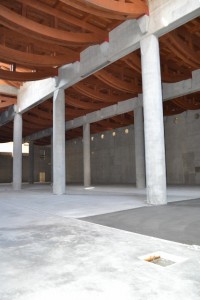 s. The building would have been a bit of a monstrosity, marring the beautiful landscape given its behemoth size, but the winery is actually built into the side of a hill. A big hill. Thus, the underground levels practically disappear.
s. The building would have been a bit of a monstrosity, marring the beautiful landscape given its behemoth size, but the winery is actually built into the side of a hill. A big hill. Thus, the underground levels practically disappear.
Gingerly walking down flight after flight, I was given a tour of each floor with Masottina’s Marketing Manager, Federico dal Bianco. In viewing the structure, Masottina appears to be sparing no expense. The concrete floors share space with stunning wood beams overhead, recalling the hull of a graceful ship, while the sheer height of the space, along with the massive support columns, puts one in mind of a church or Greek temple. It was impressive as a work-in-progress; it will be incredible to see completed.
But, despite spending about an hour at the site, plus a brief visit to their nearby vineyards, there was no wine, of course. Fortunately, I had the opportunity to taste through the Masottina wines at the Vino in Villa event later that evening.
While I did enjoy their Conegliano Valdobbiadene Prosecco Superiore wines in both Brut and Extra Dry styles, it was their Rive-designated wine that stole my heart. Rive wines are a new classification that were introduced with the new regulations, which promoted Prosecco Superiore to DOCG status, and indicate wines that are harvested from a single vineyard in one of hte designated zones and at lower yields.
Conegliano Valdobbiadene Prosecco Superiore Extra Dry “Rive di Ogliano” 2011
Aromas of floral, pear and minerality greeted the nose and were repeated on the palate. Not surprisingly, given that it was labeled as Extra Dry, the wine did display a hint of sweetness on the palate, but it was coupled with sufficient acidity to balance the slight residual sugar. This balance remained throughout the wine’s long length.
Beyond Prosecco Superiore, Masottina also produces wines under several other denominations, including the (also newly promoted) Colli di Conegliano DOCG. Thus, when I arrived in Venice a few days later, I was delighted to see the Massotina Colli di Conegliano Bianco on the list at Al Covo. Admittedly, I didn’t take any tasting notes on this blend of Incrocio Manzoni , Chardonnay, Pinot Blanc, Sauvignon Blanc and Riesling, but, trust me, it was a lovely pairing with my meal.
Lesser-known Names Shine in the Langhe
Italy’s Piedmont region is full of recognizable names – Michele Chiarlo, Aldo Conterno and Bartolo Mascarello to list just a few. But the area has numerous other producers who, while less well known, are also producing high quality wines. Two such visits that reinforced this view were to Gianpiero Marrone and Negro.
A man blessed with daughters, Giampiero Marrone is at the helm of his family’s winery, with daughters Serena, Denise and Valentina working alongside him. Located in La Morra, the Marrones recently completed a major renovation of their winery building, which has been in the family for four generations. Standing on the new terrace, the 360° views provide a glimpse of 11 different bell towers, which serve as a beautiful backdrop to tasting the wines.
With 18 hectares (~45 acres) planted, the Marrones produce both red and white wines. Their diverse portfolio (they produce 20 different wines) offers some more unique selections such as Favorita, a grape so named for the Queen’s partiality to this wine. This traditional white grape is found only in the Langhe, but it originated from Vermentino when both Piedmont and Sardinia were under Savoy rule. This wine (2011) is light and fresh, well suited as an aperitif, with floral notes, ripe peach fruit and moderate acidity.
Their Langhe Arneis (another local white grape variety) comes from a vineyard selection called “Tre Fie” (three daughters). Redolent of almond, floral and citrus notes, the 2011 wine is rich and mineral on the palate. A blend of Arneis, Sauvignon Blanc and Chardonnay, the Langhe Suris 2010 is quite tropical in aroma, coupled with citrus, along with full body and vibrant acidity. Rounding out the family’s white wine offerings, its Langhe Chardonnay “Memundis” is barrel fermented and spends 15 months on the lees. The 2010 was nicely structured with integrated oak, apple, mineral and a hint of butter and capable of aging for a few years.
Among its reds, the Marrones produce several blends including Passione from a blend of Barbera and Nebbiolo, and Sancarlo, which brings together Nebbiolo, Barbera and Dolcetto. The former was rich and ripe with bright cherry aromas and flavors and freshness on the palate. The latter displayed a dried, jammy fruit character, with cherry, plum and herbal notes and was quite elegant. Serena explained that they prefer Austrian wood for their barrels, which are water bent, but not charred or smoked, and choose a smaller size to speed the aging process.
Conversely, their Barolo “Pichemej” is aged in traditional, large oak casks. The 2008 was still extremely tight, but exhibited nice floral, cherry and spice aromas and flavors. It needs time in the cellar for the tannins to soften. We closed out the visit with their Barolo Chinato. This is a traditional aromatized wine, flavored with spices, cinchona (quinine), rhubarb roots and gentian, making it equally perfect as a digestif or as an accompaniment to dessert. The medium sweet palate offered spices, cocoa and stewed fruit, yet finished quite cleanly.
Situated to the north of Barolo, the Roero DOCG features Arneis and Nebbiolo. While this denomination hasn’t garnered the attention that Barolo and Barbaresco have attained, the area produces extremely high quality wines, particularly with the whites. Here, the Arneis grape thrives in the marine-fossil rich soils that maintain high acidity in the grapes.
Within Roero, the Negro family has been producing wine for generations. Their Perdaudin estate dates to 1670 as evidenced in the local archives. The current generations include Giovanni and Marisa Negro and their children, Emanuela, Gabriele, Angelo and Giuseppe, making the winery a true family affair. Recognizing the need to sustain the land for future generations, the family has shifted its vineyard cultivation from the use of chemical fertilizers to organic compost.
Championing the aging potential of Arneis, the Negro family presented a vertical tasting of their Arneis wines. The 2001 Roero Arneis 7 Anni proved the point, showing some development, while retaining crisp acidity, minerality and a creamy texture. Surprisingly, the 2007 Roero Arneis “Perdaudin” actually seemed older with its slight oxidative character of nuts and bruised apples.
The Negro’s Roero Sudisfà Riserva provided proof as to the quality of the Roero Rosso (red) wines. These were quite elegant, despite the tannic nature of the wines. The 2004 and 2006 particularly showed well, with the 2004 offering dried flowers, balsamic vinegar and plums on the nose, with dried fruit and meatiness on the palate. Overall, it showed richer, darker fruit than the 2006, which displayed similar floral character, but was joined by brighter strawberry aromas and flavors.
Like the Marrones, the Negros have a significant range of wines. Their two Metodo Classico sparkling wines include the Giovanni Negro Roero Arneis Extra Brut and the Maria Elisa Rosé Brut, produced from Nebbiolo, while the two dessert style wines include Birbet, an off-dry wine made from Brachetto (but unlike Brachetto d’Acqui, this isn’t a sparkling wine), and Passito, a medium sweet wine made from Arneis grapes that have been dried to reduce water content and concentrate flavors.
These two visits reinforced the need to look beyond the usual suspects and to explore the broader world of Piedmont wine.
Grand Cru Grapevine: Memories of Mendocino (September 2012)
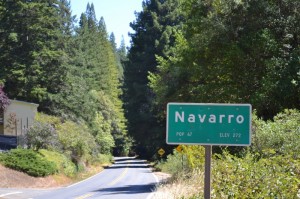 Nestled above the Sonoma County border, Mendocino County is a world unto its own. Much less developed than Napa or Sonoma, the county is home to sandy beaches, towering redwood forests, and other natural landscapes, but little else. The picturesque town of Mendocino itself sits along the Pacific Ocean, offering breath-taking views, weather permitting. On a clear day, you can watch waves crash on the rocks below; however, when the fog rolls in, you’re lucky if you can see the ocean at all.
Nestled above the Sonoma County border, Mendocino County is a world unto its own. Much less developed than Napa or Sonoma, the county is home to sandy beaches, towering redwood forests, and other natural landscapes, but little else. The picturesque town of Mendocino itself sits along the Pacific Ocean, offering breath-taking views, weather permitting. On a clear day, you can watch waves crash on the rocks below; however, when the fog rolls in, you’re lucky if you can see the ocean at all.
Beyond swimming and hiking, beer and wine tasting figure prominently on tourists’ “to do” lists. Even though grapes are grown throughout the county, with a total of ten American Viticultural Areas (and two pending approval), it is the Anderson Valley that is the most densely populated – with wineries, not people. Arriving from the north, visitors are greeted by the Navarro town limit sign, which announces a whopping population of 67; this is not the place to annoy your neighbor. To the south, the “much bigger” Boonville is home to 700 residents. But, what the area lacks in people, it more than makes up for in hospitality and a stay at the Boonville Hotel is strongly recommended.
Within the valley, the elevation, coupled with the coastal maritime influence, creates ideal conditions for cool climate grape varieties including Pinot Noir, Chardonnay, Gewürztraminer and Riesling. Although Tony Husch is credited with planting the valley’s first Pinot Noir vines in 1971, the Alsatian varieties got their start in 1974, thanks to Ted Bennett and Deborah Cahn of Navarro Vineyards. And, while aromatic whites do well, Pinot Noir is especially prized, with many producers coming from outside the valley to source fruit, such as Copain, Fulcrum and Littorai. Aside from producing highly regarded still wines, Pinot Noir and Chardonnay also find themselves used in the production of Traditional Method sparkling wines. In this regard, Scharffenberger Cellars was founded by John Scharffenberger in 1981, while Roederer Estate, affiliated with Champagne house Louis Roederer, was established in 1982.
Today, the Anderson Valley remains quite small with a scant 2,244 acres planted on 85 properties and a median vineyard size of 12 acres. To put that in perspective, the Napa Valley, which accounts for only 4% of California’s total wine production, has over 45,000 acres of vineyards. Yet, despite the Anderson Valley’s diminutive size, it has developed a big reputation for producing quality wines.
Roederer Estate L’Ermitage 2003, Anderson Valley, CA, $44.00
The top sparker of the estate, also known as a tête de cuvée, L’Ermitage made its debut in 1989 and is only made in the best years. This wine is a blend of 52% Chardonnay and 48% Pinot Noir and spent five years on the lees. It showed floral, yeast and citrus notes on both the nose and palate, culminating in a very long length. 8,332 cases produced
Navarro Vineyards Pinot Gris 2010, Anderson Valley, CA, $19.00
With a strong emphasis on sustainable farming, the family farm supports a flock of Babydoll sheep, which graze between the vines to keep
down the weed, but are too short to reach the grapes. The wine shows floral, almond and tangerine notes on the nose, all of which persisted on the lush palate. 1,500 cases produced
Handley Cellars Pinot Noir 2009, Anderson Valley, CA, $32.00
Owned by Milla Handley, Handley Cellars celebrates its 30th vintage this year, and while Milla is still the primary winemaker, co-winemaker, Kristen Barnhisel, joined the staff in 2004. This Pinot Noir was redolent of fresh berries and cherries, with earth, slight spice and dried herbs joining on the palate. 1,505 cases produced
Phillips Hill Estates Pinot Noir Wiley Vineyard 2009, Anderson Valley, CA, $38.00
Phillips Hill Estates was founded by Toby Hill in 2002 when the professionally-trained artist shifted his attention away from the label and into the bottle (although he does design his own labels). Crafting several different vineyard designate Pinot Noirs, the Wiley Vineyard was our favorite with its lighter body, yet still intense cherry aromas and flavors. 380 cases produced
Lula Cellars Zinfandel 2009, Mendocino, CA, $28.00
This relatively new direct to consumer brand – the first wines were launched with the 2008 vintage – is the brainchild of winemaker and owner, Jeff Hansen. With grapes sourced from just south of Ukiah, this wine displayed blueberry, cocoa and raspberry aromas with rich and ripe fruit on the dry palate. 500 cases produced

